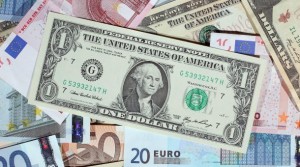 Friday’s trade saw EUR/USD within the range of 1.0834-1.0958. The pair closed at 1.0886, falling 0.50% on a daily basis and following a 3.07% surge on Thursday, or the largest one in more than five years. In weekly terms, EUR/USD advanced 2.77% last week, or the most since the week ended on May 3rd, when it appreciated 3.01%. The pair has risen 2.87% so far during the current month.
Friday’s trade saw EUR/USD within the range of 1.0834-1.0958. The pair closed at 1.0886, falling 0.50% on a daily basis and following a 3.07% surge on Thursday, or the largest one in more than five years. In weekly terms, EUR/USD advanced 2.77% last week, or the most since the week ended on May 3rd, when it appreciated 3.01%. The pair has risen 2.87% so far during the current month.
At 7:41 GMT today EUR/USD was down 0.15% for the day to trade at 1.0864. The pair touched a daily low at 1.0855 at 2:40 GMT, undershooting the range support level (S3). Short-term support may be received in the area around the low from December 4th (1.0834), while resistance may be encountered at the psychological 1.0900 level.
Today EUR/USD trading may be influenced by the macroeconomic reports listed below.
Fundamentals
Euro area
Sentix Investor Confidence
Confidence among investors in the Euro zone probably continued to improve in December, with the corresponding index coming in at a reading of 17.0, according to market expectations. If so, December would be the 12th consecutive month, during which the gauge occupied positive territory. In November the index stood at 15.1. The index is based on results from the SENTIX survey, one of the most prominent surveys, reflecting investors’ opinion in Germany. It encompasses 2 800 respondents, with 510 of them being institutional investors. Respondents present their expectations regarding ten different markets for a period of one and six months. Readings above zero indicate that respondents were predominantly optimistic, while readings below zero show pessimism. Higher-than-expected readings would have a limited bullish effect on the common currency. The official index value is due out at 9:30 GMT.
United States
Change in consumer credit
The money amounts, borrowed by consumers probably increased by USD 20.0 billion in October, according to market expectations, following a surge by USD 28.92 billion in September. The latter was mostly supported by non-revolving credit (auto and student loans), which rose by USD 22.23 billion. In addition, revolving credit (credit cards mostly), grew by USD 6.69 billion in September.
Given the current state of the economy, a higher-than-expected amount borrowed is usually considered as dollar positive, as it implies a potential increase in consumer spending and accelerated growth, respectively. The Board of Governors of the Federal Reserve is to release the official numbers at 20:00 GMT.
Correlation with other Majors
Taking into account the week ended on December 6th and the daily closing levels of the major currency pairs, we come to the following conclusions in regard to the strength of relationship:
EUR/USD to NZD/USD (0.7900, or very strong)
EUR/USD to GBP/USD (0.7322, or strong)
EUR/USD to AUD/USD (0.7269, or strong)
EUR/USD to USD/CAD (0.2882, or weak)
EUR/USD to USD/JPY (-0.4923, or moderate)
EUR/USD to USD/CHF (-0.9798, or very strong)
1. During the examined period EUR/USD moved strongly in one and the same direction with GBP/USD and AUD/USD.
2. EUR/USD moved almost equally in one and the same direction with NZD/USD, while moving almost equally in the opposite direction compared to USD/CHF.
3. The correlation between EUR/USD and USD/CAD was insignificant during the period in question.
Bond Yield Spread
The yield on German 2-year government bonds went as high as -0.276% on December 4th, or the highest level since November 9th (-0.276%), after which it closed at -0.296% to add 0.009 percentage point in comparison with December 3rd. It has been the second consecutive trading day of increase.
The yield on US 2-year government bonds climbed as high as 0.991% on December 4th, after which it closed at 0.947% to lose 1.2 basis points (0.012 percentage point) compared to December 3rd. It has been the third drop in the past 15 trading days.
The spread between 2-year US and 2-year German bond yields, which reflects the flow of funds in a short term, narrowed to 1.243% on December 4th from 1.266% on December 3rd. The December 4th yield spread has been the lowest one since November 18th, when the difference was 1.243% as well.
Meanwhile, the yield on German 10-year government bonds soared as high as 0.742% on December 4th, or the highest level since September 17th (0.791%), after which it slid to 0.690% at the close to add 2.1 basis points (0.021 percentage point) compared to December 3rd. It has been the second consecutive trading day of increase.
The yield on US 10-year government bonds climbed as high as 2.358% on December 4th, or the highest level since November 9th (2.377%), after which it slipped to 2.273% at the close to lose 4.8 basis points (0.048 percentage point) compared to December 3rd. It has been the eighth drop in the past ten trading days.
The spread between 10-year US and 10-year German bond yields narrowed to 1.583% on December 4th from 1.652% on December 3rd. The December 4th yield difference has been the lowest one since October 26th, when the spread was 1.558%.
Daily and Weekly Pivot Levels
By employing the Camarilla calculation method, the daily pivot levels for EUR/USD are presented as follows:
R1 – 1.0897
R2 – 1.0909
R3 (range resistance) – 1.0921
R4 (range breakout) – 1.0954
S1 – 1.0875
S2 – 1.0863
S3 (range support) – 1.0852
S4 (range breakout) – 1.0818
By using the traditional method of calculation, the weekly pivot levels for EUR/USD are presented as follows:
Central Pivot Point – 1.0802
R1 – 1.1066
R2 – 1.1246
R3 – 1.1510
S1 – 1.0622
S2 – 1.0358
S3 – 1.0178





